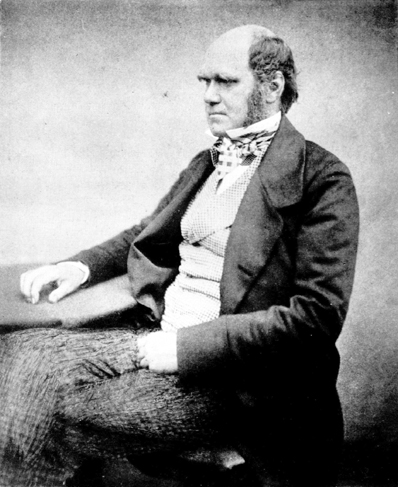 A.
Overview:
A.
Overview:
One of the great ironies of science is that the two greatest contributions in biology - the theory of evolution and the mechanistic principles of heredity - were described independently of one another within a ten year period. It is ironic because genetics (heredity) and evolution are so critically and intimately related...heredity describes how genetic information is passed from parent to offspring. This creates relatedness patterns within families, within species among populations, and among species. These relationships are a focus of evolutionary studies. The publications marking their official, orthodox ‘births’ were published only six years apart: Origin of Species (1859), and Experiments in Plant Hybridization (1865), yet it was nearly 80 years before these ideas were placed in their proper context within the Modern Synthetic Theory of evolution. In the first part of this course, we will examine these contributions in a historical context. We will also briefly describe the cellular context in which the genetic system operates.
 A.
Overview:
A.
Overview: a. He summarized
the evidence for evolution (common descent) as an historical fact
b. He proposed mechanistic theories explaining ‘how’ evolution
might occur (Natural Selection, use and disuse)
c. He addressed the major problems with his ideas; notably
the ideas of apparent design (Paley), the discontinuity of the fossil record
(Cuvier), and the source of observed variation.
1. Geology
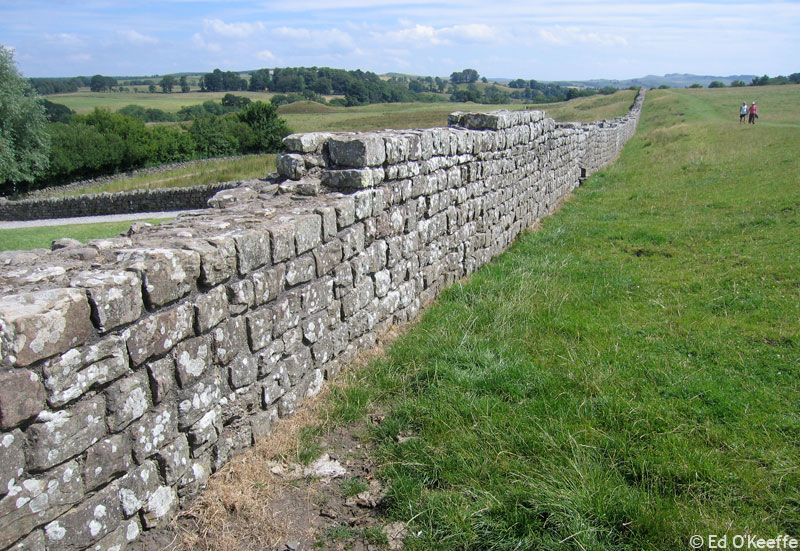 a.
James
Hutton (1726-1797): Hutton was the first great british geologist.
He compared Hadrian's wall - which looks new but was 1600 years old (122 AD)
- with natural rock outcrops that were strongly weathered. Hutton concluded
that the natural outcrops must be 100's of times older. He also examined an
important formation at Siccar Point, where one series of nearly vertical strata
is overlain by another series of horizontal strata. This is now called an 'unconformity',
and Hutton explained it as follows. Based on Steno's laws of superposition,
the bottom vertical sediments must have been laid down first, and they must
have been laid down horizontally. Ages must have passed between each deposit,
as each turned to rock. Then, uplifts must have occurred to bend them into a
vertical aspect. Long periods of erosion must take place to wear that uplift
flat, followed by the long intervals of time needed to deposit the second horizontal
series. Also, if erosion and deposition acted slowly (as current observations
show), then it must have taken a really long time to erode mountains or build
up marine deposits (White Cliffs of Dover). He concluded that this slow, 'uniformitarian'
cycle of deposition, uplift, erosion, and deposition meant that the Earth was
unfathomably old. Indeed, the cycle may mean that it's age might not be discoverable.
In short, Hutton concludes, the Earth has "no vestige of a beginning, no prospect
of an end."
a.
James
Hutton (1726-1797): Hutton was the first great british geologist.
He compared Hadrian's wall - which looks new but was 1600 years old (122 AD)
- with natural rock outcrops that were strongly weathered. Hutton concluded
that the natural outcrops must be 100's of times older. He also examined an
important formation at Siccar Point, where one series of nearly vertical strata
is overlain by another series of horizontal strata. This is now called an 'unconformity',
and Hutton explained it as follows. Based on Steno's laws of superposition,
the bottom vertical sediments must have been laid down first, and they must
have been laid down horizontally. Ages must have passed between each deposit,
as each turned to rock. Then, uplifts must have occurred to bend them into a
vertical aspect. Long periods of erosion must take place to wear that uplift
flat, followed by the long intervals of time needed to deposit the second horizontal
series. Also, if erosion and deposition acted slowly (as current observations
show), then it must have taken a really long time to erode mountains or build
up marine deposits (White Cliffs of Dover). He concluded that this slow, 'uniformitarian'
cycle of deposition, uplift, erosion, and deposition meant that the Earth was
unfathomably old. Indeed, the cycle may mean that it's age might not be discoverable.
In short, Hutton concludes, the Earth has "no vestige of a beginning, no prospect
of an end."
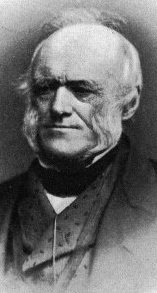 b.
Charles Lyell (1797-1895):
Lyell promoted Hutton's ideas of a great age to the Earth and uniform rates
of change - making inferences based on the assumption of constant rates of physical
processes. Small changes, accumulating over a long time, could have big
effects. Lyell's three volume work Principles of Geology (1830-33)
opened Darwin's eyes as he read them on the H.M.S. Beagle. Geology opened "deep
time".... the Earth was at least 100's of thousands of years old, and natural
processes working slowly, gradually, and cumulatively through time could affect
large changes. Lyell was Darwin's contemporary and personal friend, although
he was distressed by Darwin's evolutionary ideas.
b.
Charles Lyell (1797-1895):
Lyell promoted Hutton's ideas of a great age to the Earth and uniform rates
of change - making inferences based on the assumption of constant rates of physical
processes. Small changes, accumulating over a long time, could have big
effects. Lyell's three volume work Principles of Geology (1830-33)
opened Darwin's eyes as he read them on the H.M.S. Beagle. Geology opened "deep
time".... the Earth was at least 100's of thousands of years old, and natural
processes working slowly, gradually, and cumulatively through time could affect
large changes. Lyell was Darwin's contemporary and personal friend, although
he was distressed by Darwin's evolutionary ideas.
2. Paleontology
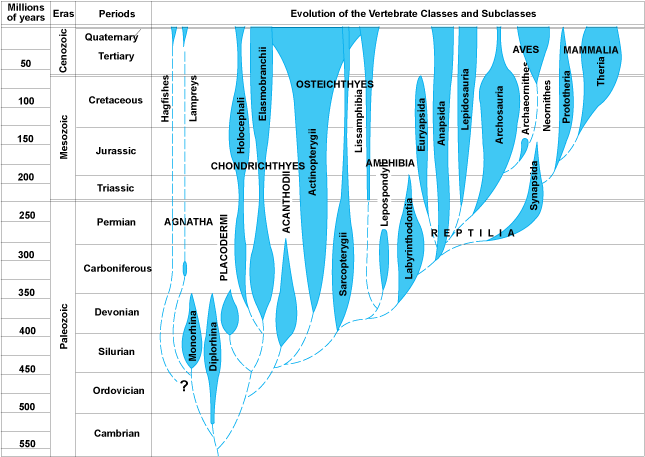 Paleontology
provided a variety of interesting patterns. First, there were extinct forms
that were different from the species alive today. Although some earlier natural
philosophers suggested that the creatures might still exist in some unexplored
corner of the globe, that was a less satisfying hypothesis in the mid-1800's...
most areas of the globe had been visited by Europeans. Also, the idea of extinction
was repugnant to some people on theological grounds. If God had created a perfect
world, then extinction renders that creation imperfect. Also, if species could
go extinct since the creation, could species also come into existence since
the creation? Just how dynamic was this system?
Paleontology
provided a variety of interesting patterns. First, there were extinct forms
that were different from the species alive today. Although some earlier natural
philosophers suggested that the creatures might still exist in some unexplored
corner of the globe, that was a less satisfying hypothesis in the mid-1800's...
most areas of the globe had been visited by Europeans. Also, the idea of extinction
was repugnant to some people on theological grounds. If God had created a perfect
world, then extinction renders that creation imperfect. Also, if species could
go extinct since the creation, could species also come into existence since
the creation? Just how dynamic was this system?
Darwin was impressed by two major patterns in the fossil record.
1. The major groups of animals accumulate in an orderly manner'. Everything is not represented at the beginning. In vertebrates, for instance, the fishes appear first, and exist throughout the rest of the record. Amphibians appear next, followed by reptiles, mammals, and birds. So it is not everything at the beginning, and it is not a replacement. Where did mammals come from? Spontaneous generation had been refuted, so Darwin knew that mammals had to come from other pre-existing animals. But the only completely terrestrial vertebrates before mammals were reptiles.
2. A second major pattern occurred within some lineages of similar organisms. Within some lineages, we seen orderly change in the size or characteristics of species in a geological sequence. For instance, consider the morphological patterns in a particular taxon (horses). Fossils in a stratigraphic sequence are similar, but often have traits that form a continuum...like the progressive loss of digits on the horse limb. And, with each innovation, there are often radiations - a "spurt" in the number of species that show this new trait. And finally, these species in recent strat are more similar to living ('extant') species than the species found in deeper, older strata. So, many of these transitional sequences terminate in living representatives.
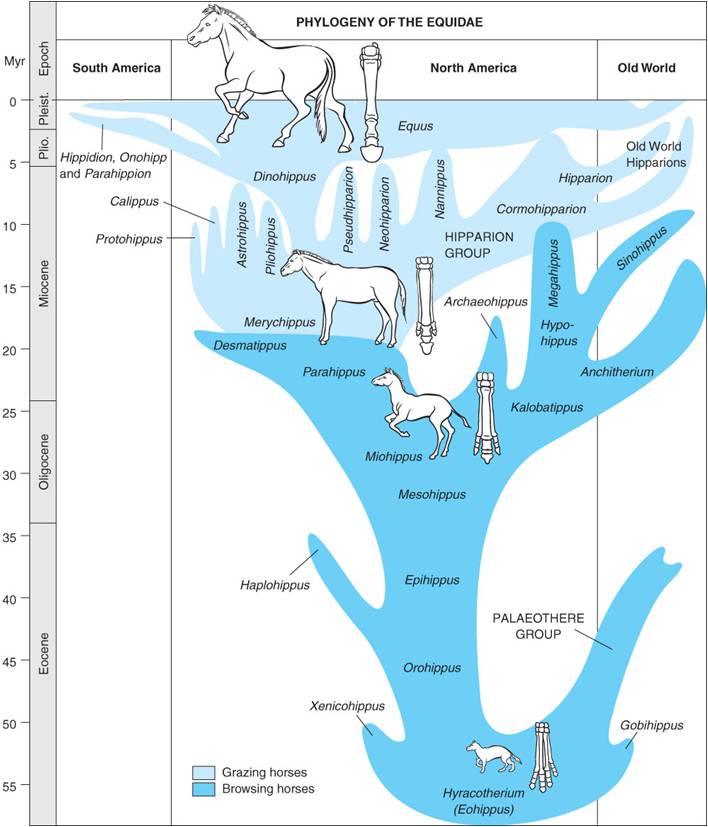
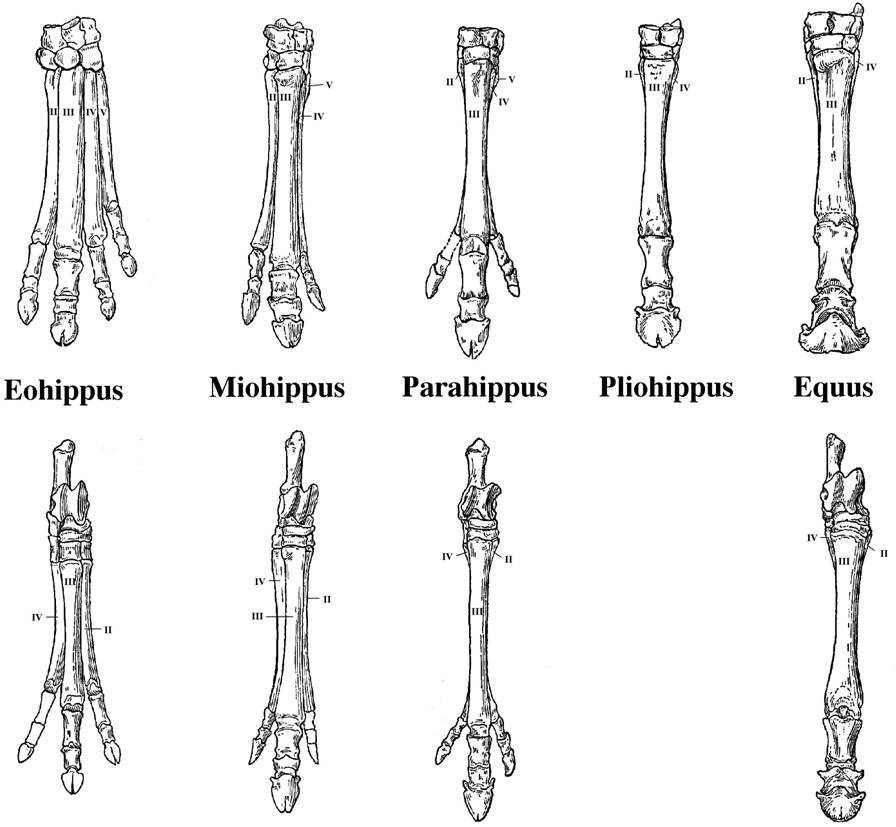
3. Comparative Anatomy
 a.
Homologous Structures
a.
Homologous Structures
Although having a different outward "look" and although used
for different purposes, they have an underlying similarity in structure - forelimbs
of vertebrates all have one long upper arm bone, two lower arm bones, a bunch
of wrist bones, and five digits. Darwin saw the similarity in structure as important.
An engineer builds different things for different purposes - cars, boats, and
airplanes are structurally DIFFERENT. Here, however, it seemed as if one basic
structure was modified for different uses. Darwin knew why siblings in a family
were similar - they had the same parents (ancestors). He reasoned that these
structural similarities in different species might be due to the same principle
- common ancestry. Also, he observed a correlation: Different uses correlated
with different environments. Could this correlation be causal?
b. Analogous
Structures
Organisms in the same environment often have a similar outward
structure or body plan. For example, flying animals all have an aerodynamic
wing that is wider at the front than at the rear. However, the wings of differnt
animals are differnt in underlying structure. Bats have fingers that support
the membraneous wing, whereas birds lack fingers and the body of the wing consists
of feathers. Insect wings don't involve the limbs at all (even though they have
6!). Again, Darwin observed this correlation with the environment: similar use
(and outward structure) in similar environments. Could this correlation be causal?
c.
Vestigial Organs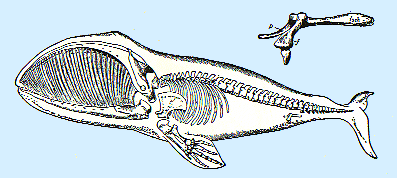
These are organs that have no function in one organism (where
they are 'vestigial') but they do function in other organisms. So, some whales
have hip bones, but no legs. Why do they have these bones? Darwin was struck
by the IMPERFECTIONS in nature, as much as the adaptations. Why do men have
nipples? Why do we have muscles that wiggle our ears? Why do we have strong
muscles in the front of our stomach, which are not "load-bearing", and weak
muscles at the base of our abdomen (which rupture in a hernia)? This is a reasonable
relationship in a quadraped, but not in a biped. Why do we have tail bones,
but no external tail? Again, these are NOT well-designed features. In fact,
attributing these imperfect designs to a perfect creator could be interpreted
as heretical. However, when we see them working in OTHER species, it suggests
that maybe we inherited them from common ancestors where they DID serve a function.
As a scientist, Darwin was trying to explain ALL the data (adaptations and imperfections),
he was not simply bringing forward only the data that supported a preferred
position (design).
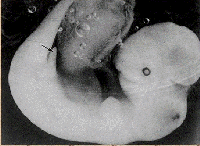 d.
Embryology
d.
Embryology
Embryology reveals homologies and
vestigial structures in both the anatomy of embryos and the process of their
development. For Darwin, the notion that very different vertebrates, such as
fish, amphibians, reptiles, birds, and mammals, would develop from very similar
initial forms was inexplicable from a 'separate creation' perspective. For example,
why do whale embryos (like the one pictured to the right) have hind limb buds?
Why do all vertebrates have folds of tissue in the neck, when only fish develop
them into functional gill slits in the adult? Some anomalies like the recurrent
laryngeal nerves of mammals (described in your book) are explicable in a developmental,
comparative, evolutionary context. Although no modern evolutionary biologist
propounds the notion that an organism "traces their evolutionary history"
as they develop from an egg (this was Haeckel's post-Darwinian idea that "ontogeny
recapitulates phylogeny"), and Haeckel's drawings grossly exaggerated the
similarities among vertebrate embryos, embryos are far more similar to one another
than adults, and embryos are more similar to other embryos than they are to
their own adult form. As we will see when we look at modern contributions from
genetics and developmental biology, the similarities in development are even
more dramatic than anatomy alone suggests.
4. Biogeography
a. Community
convergence
Under similar environmental conditions, we find different
species filling similar ecological niches. Outward 'form' correlates with
ecological niche (role) across entire communities. So, in Australia, marsupials
fill the role of dog-like predator, cat-like predator, burrowing animal, ant-eater,
etc. These same roles are filled by outwardly similar placental mammals in South
America. However, the similarity between a wolf (placental) and a Thylacine
(marsupial - the 'tasmanian wolf') are strictly ANALOGIES. Their underlying
structure shows them to be quite different - a wolf is more similar to a ground
hog (both placentals) in underlying structure than to a thylacine.
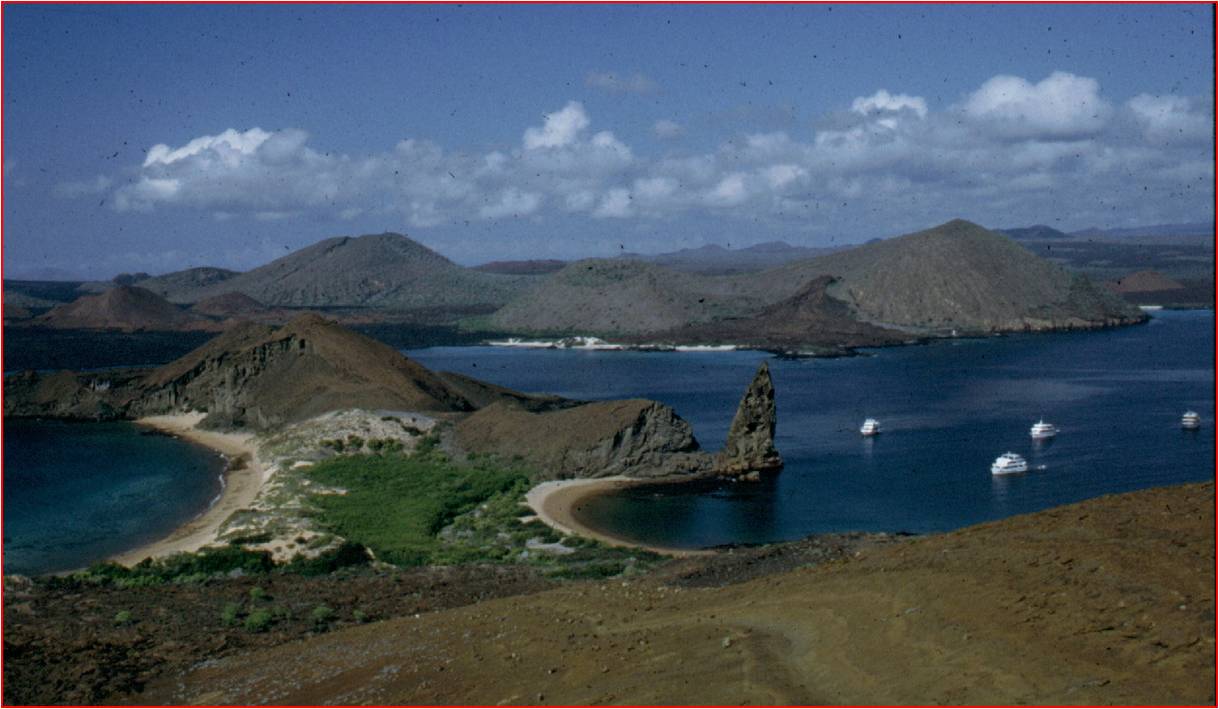 b.
Islands Faunas
b.
Islands Faunas
Islands often have fewer species than a mainland - even a patch of mainland the same size. As such, the patterns and interactions are often simpler to describe and understand. For both Darwin and Alfred Russel Wallace (the other independent author of the theory of evolution by natural selection), the study of islands was critical in to the development of their ideas.
1. Distance correlates with the uniqueness of the inhabitants: the animals on the Fauklands are the same species as on the mainland, but the Galapagos fauna is composed of unique species, found nowhere else:
"The natural history of these islands is eminently curious, and well deserves
attention. Most of the organic productions are aboriginal creations, found nowhere
else; there is even a difference between the inhabitants of the different islands;
yet all show a marked relationship with those of America, though separated from
that continent by an open space of ocean, between 500 and 600 miles in width.
The archipelago is a little world within itself, or rather a satellite attached
to America, whence it has derived a few stray colonists, and has received the
general character of its indigenous productions. Considering the small size
of the islands, we feel the more astonished at the number of their aboriginal
beings, and at their confined range. Seeing every height crowned with its crater,
and the boundaries of most of the lava- streams still distinct, we are led to
believe that within a period geologically recent the unbroken ocean was here
spread out. Hence, both in space and time, we seem to be brought somewhat near
to that great fact -- that mystery of mysteries -- the first appearance of new
beings on this earth." The Voyage of the Beagle - Darwin (1839).
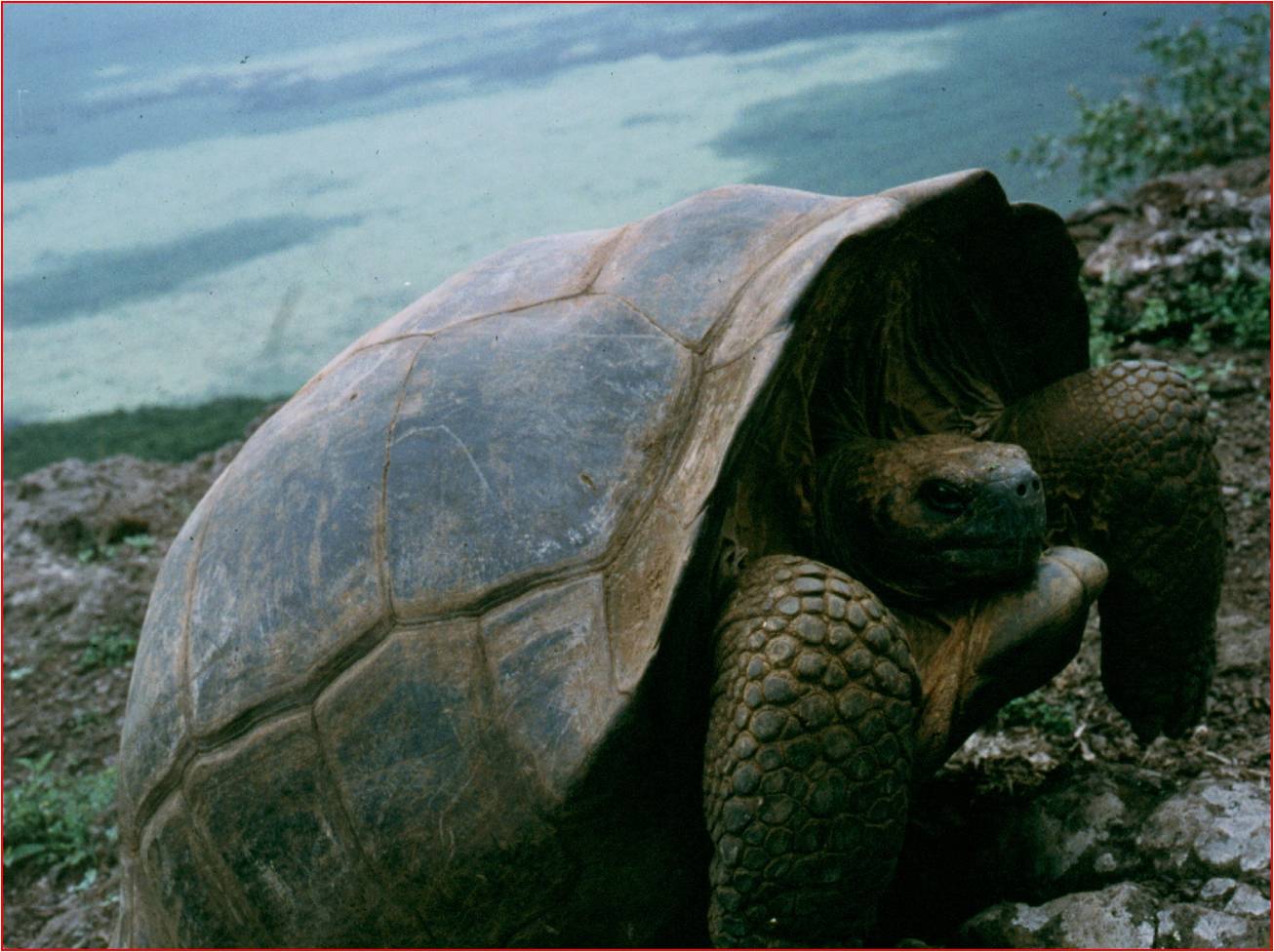 2. The Galapagos fauna:
2. The Galapagos fauna:
- It was related to american fauna,
yet different: the types of animals are new world animals.... there are iguanas
like the green iguana of Central and South America, but the iguanas are different
species. So, darwin describe it as " a world within itself, or rather,
a satellite of the Americas" .... it was different, but more like the American
fauna than any other...(no chameleons, for instance, which are old world lizards...)
- It was dominated by dispersive forms. This is critical. The communities are dominated by reptiles, birds, and marine mammals. All of these organisms could MIGRATE to the islands from the mainland. (Terrestrial mammals don't migrate as well as terrestrial reptiles over open ocean. Throw a reptile in cold salty water, and: 1) its metabolism slows down (its cold), so 2) its demand for food and water decline; and 3) its scales protect it against water loss... which is why reptiles do well in the desert, too. Throw a mammal in cold salt water, and it's going to have a VERY tought time: 1) the temperature gradient between its warm body and the cold ocean is very large - in order to maintain its high body temperature against this gradient, it's metabolism has to INCREASE (to produce more heat to compensate for the heat lost to the environment). This increased metabolic demand will INCREASE the need for food and water... that's probably in pretty short supply in the open ocean; and 2) water is lost quickly from the skin to the salty ocean once the fur is wet... so, mammals are more likely to starve or die of exposure than reptiles.
- So, the islands are dominated by dispersive forms, and this suggests they came from America. But if they came from America, WHY ARE THEY DIFFERENT SPECIES THAN THOSE IN AMERICA? They must have changed since their arrival.
- There are even differences between
species on different islands. On the 14 species of finches - "Seeing this gradation
and diversity of structure in one small, intimately related group of birds,
one might really fancy that from an original paucity of birds in this archipelago,
one species had been taken and modified for different ends." The Voyage
of the Beagle - Darwin (1839)  VIDEO
VIDEO
- Galapagos Mockingbirds Darwin thought he had one, very variable species. He
sent specimens to John Gould, the premiere ornithologist in England at the time.
On Darwin's return to England, he found out that Gould recognized the mockingbird
specimens as belonging to 4 separate species. This made Darwin consider that
maybe the variation WITHIN a species could be continuous with the variation
BETWEEN species.... maybe varieties within a species could gradually become
so different from one another that they would eventually become different species.
VIDEO
5. Argument For Evolution as a Historical Fact:
Premise 1: Species that are alive today are different from those that have lived previously.
Premise 2: Spontaneous Generation is refuted, so organisms only come from other organisms.
Conclusion 1: Thus, the organisms alive today must have come from those pre-existing, yet different, species.
Conclusion 2: There must have been change through time (evolution).
Conclusion 3: The fossil record, vestigial organs, and homologies are all suggestive of descent from common ancestors.Below, the figure from The Origin of Species that shows Darwin's idea of descent from common ancestors.
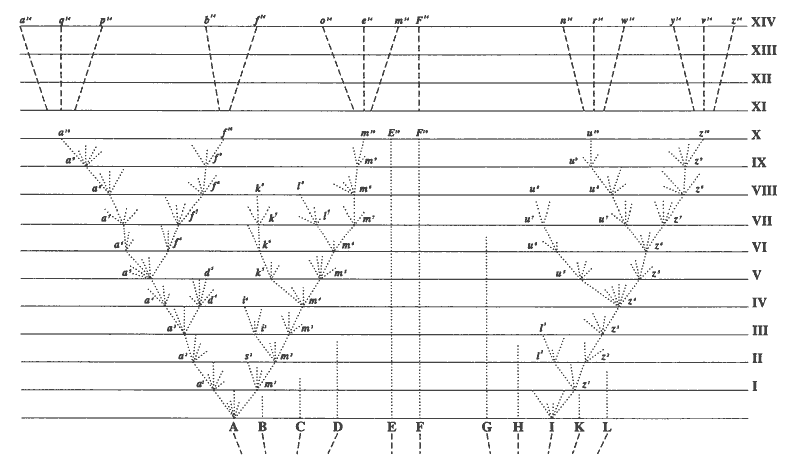
So, if species do change over time (evolve), the next question is "How?" How does this change occur?
1. Transitional Observations
 a.
Domesticated animals:
a.
Domesticated animals:
As a result of selective breeding, humans have taken certain species and modified them tremendously. So, from an ancestral population of wolves, we have created chihuahuas and St. Bernards. Now, there were never any Chihuahua sized wolves running around - we created this variability by progressively breeding smaller dogs with one another. Now, we have two groups, Chihuahuas and St. Bernards, that can't easily be bred together. So, we have created separate biological groups, that could be called different species. Darwin was aware of many 'breeds' of pigeons, too. These were called varieties, almost assuredly descended from a common ancestral population of rock doves (left). The KEY to the production of new varieties by humans is that humans only allowed certain organisms to breed. So, only particular traits were passed to the next generation. Darwin wondered if there was a mechanism that could do the SAME thing in nature (only allow certain organisms in a population to breed), and thereby explain the natural changes seen in the fossil record (radiational patterns of multiple species in one strata necessarily coming from fewer species in earlier strata). and implied by island faunas. Just because man does it purposefully, by design and with aforethought, doesn't mean that nature can't do it WITHOUT purpose. We put water in the freezer to PURPOSEFULLY make ice cubes... but water freezes naturally, as well - without a purpose, but with the same NATURAL CAUSE (loss of heat).
 b. Reading Malthus:
b. Reading Malthus:
In 1838, Darwin read a book published in 1798 by Thomas Malthus called Essay on the Principle of Population. Malthus was a british aristocrat who was concerned that the british aristocracy might be overthrown like the French had been 10 years before (1788). He realized that all populations have the capacity to grow exponentially, but that resources are finite. As such, there will eventually be a "struggle for existence" (Darwin's words). Malthus was worried that the british population would continue to grow, and that poverty and famine would lead to revolution.
Darwin read Malthus, and wrote in his autobiography:
“In October 1838,
that is, fifteen months after I had begun my systematic enquiry, I happened
to read for amusement Malthus on Population and being well prepared to appreciate
the struggle for existence which everywhere goes on from long-continued observation
of the habits of animals and plants, it at once struck me that under these circumstances
favourable variations would tend to be preserved, and unfavourable ones to be
destroyed. The result of this would be the formation of new species. Here, then,
I had at last got a theory by which to work; but I was so anxious to avoid prejudice,
that I determined not for some time to write even the briefest sketch of it.
In June 1842 I first allowed myself the satisfaction of writing a very brief
abstract of my theory in pencil in 35 pages; and this was enlarged during the
summer of 1844 into one of 230 pages, which I had fairly copied out and still
possess.” - The Autobiography of Charles Darwin
1809-1882 (Barlow 1958).
- If there are limited resources of food, shelter, and mates, and if organisms in a population vary, then as a consequence of this variability, some will be more likely to gain the resources than others, and will thus be more likely to mate. So, the environment will 'select' which animals in a population will mate (the ones best able to acquire the limiting resources)... and these traits that work to gain resources in this environment will be passed on at high frequency to the next generation.
2. Natural Selection: (Know this. Understand it. You WILL be asked to outline NS in this very form.)
P1: Populations over-reproduce (Malthus)
P2: resources are finite (Malthus)
C1: Eventually, a population will grow until it becomes limited by its resources. At that time, their will be a "struggle for existence" and most offspring produced will die. (Malthus)
P3: Individuals in a population vary, and some of this variation is heritable (Darwin - observations and animal/plant breeding)
C2: Variations will not have the same probability of survival and reproduction in a particular environment; those well-suited to the environment will be more likely to survive and reproduce than others, passing on the genes for these adapted traits. There will be "Differential Reproductive Success" (Observations, breeding).
C3: Over time, adaptive traits will accumulate and the characteristics in a population will change. This is lineage evolution. (Like change in horse toes in a sequence of fossil species, or like the change in the chihuahua lineage from the ancestral wolves).
Corollary:
Two sub-populations, separated in different environments, would be selected
for different traits and may subsequently lose the capacity to interbreed. At
this point, they are different biological species. This is Speciation and Radiational
Evolution. (like the production of different Finches, mockingbirds, etc. on
different islands in the galapagos, and like the radiation of St. Bernards AND
chihuahua's, which diverged from one another over time).
Darwin here provides a natural explanation for why purposeful structures and behaviors occurs in nature. Through some process unknown to him, variation arises in natural populations. These varieties differ in terms of functional efficiency in a common environment; so some improving an organisms probability of surviving and mating than others. Organisms with these beneficial traits will leave more offspring, and the frequencies of these beneficial characteristics will increase through time - much as humans select for smaller and smaller dogs. He ends The Origin of Species (1859) like this:
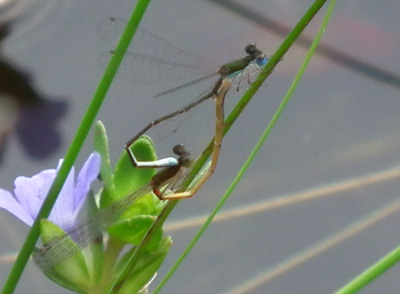 "It
is interesting to contemplate an entangled bank, clothed with many plants of
many kinds, with birds singing on the bushes, with various insects flitting
about, and with worms crawling through the damp earth, and to reflect that these
elaborately constructed forms, so different from each other, and dependent on
each other in so complex a manner, have all been produced by laws acting around
us. These laws, taken in the largest sense, being Growth with Reproduction;
Inheritance which is almost implied by reproduction; Variability from the indirect
and direct action of the external conditions of life, and from use and disuse;
a Ratio of Increase so high as to lead to a Struggle for Life, and as a consequence
to Natural Selection, entailing Divergence of Character and the Extinction of
less-improved forms. Thus, from the war of nature, from famine and death, the
most exalted object which we are capable of conceiving, namely, the production
of the higher animals, directly follows. There is grandeur in this view of life,
with its several powers, having been originally breathed into a few forms or
into one; and that, whilst this planet has gone cycling on according to the
fixed law of gravity, from so simple a beginning endless forms most beautiful
and most wonderful have been, and are being, evolved". -
The Origin of Species (Darwin 1859).
"It
is interesting to contemplate an entangled bank, clothed with many plants of
many kinds, with birds singing on the bushes, with various insects flitting
about, and with worms crawling through the damp earth, and to reflect that these
elaborately constructed forms, so different from each other, and dependent on
each other in so complex a manner, have all been produced by laws acting around
us. These laws, taken in the largest sense, being Growth with Reproduction;
Inheritance which is almost implied by reproduction; Variability from the indirect
and direct action of the external conditions of life, and from use and disuse;
a Ratio of Increase so high as to lead to a Struggle for Life, and as a consequence
to Natural Selection, entailing Divergence of Character and the Extinction of
less-improved forms. Thus, from the war of nature, from famine and death, the
most exalted object which we are capable of conceiving, namely, the production
of the higher animals, directly follows. There is grandeur in this view of life,
with its several powers, having been originally breathed into a few forms or
into one; and that, whilst this planet has gone cycling on according to the
fixed law of gravity, from so simple a beginning endless forms most beautiful
and most wonderful have been, and are being, evolved". -
The Origin of Species (Darwin 1859).
Chapter Six in "The Origin of Species" is entitled: Difficulties
on Theory
Darwin starts the chapter by writing:
"Long before having arrived at this part of my work, a crowd of difficulties will have occurred to the reader. Some of them are so grave that to this day I can never reflect on them without being staggered; but, to the best of my judgment, the greater number are only apparent, and those that are real are not, I think, fatal to my theory."
These dilemmas are:
1. How can we explain the existence of complex characteristics composed of mutually dependent parts?
- Paley's "watchmaker analogy" (1798) and the eye - the argument of design. Some elements of nature seem so complex, and composed of mutually dependent parts, that it does not seem possible that they could arise by sequential innovations. For instance, for Paley, half an eye won't work. For modern Intelligent Design proponents, the cell is called "irreducibly complex" - suggesting that it can't come from any simpler precursor - everything has to be there. (Of course, for philosophical reasons, this is about as unscientific as it gets. The idea that something is simply "too complex" to understand thwarts curiosity and stifles TRUE scientific inquiry, which is fundamentally reductionistic - as we have discussed.)
- Darwin's Solution:
 "To
suppose that the eye, with all its inimitable contrivances for adjusting the
focus to different distances, for admitting different amounts of light, and
for the correction of spherical and chromatic aberration, could have been formed
by natural selection, seems, I freely confess, absurd in the highest possible
degree. Yet reason tells me, that if numerous gradations from a perfect and
complex eye to one very imperfect and simple, each grade being useful to its
possessor, can be shown to exist; if further, the eye does vary ever so slightly,
and the variations be inherited, which is certainly the case; and if any variation
or modification in the organ be ever useful to an animal under changing conditions
of life, then the difficulty of believing that a perfect and complex eye could
be formed by natural selection, though insuperable by our imagination, can hardly
be considered real." - The Origin of Species (Darwin 1859).
"To
suppose that the eye, with all its inimitable contrivances for adjusting the
focus to different distances, for admitting different amounts of light, and
for the correction of spherical and chromatic aberration, could have been formed
by natural selection, seems, I freely confess, absurd in the highest possible
degree. Yet reason tells me, that if numerous gradations from a perfect and
complex eye to one very imperfect and simple, each grade being useful to its
possessor, can be shown to exist; if further, the eye does vary ever so slightly,
and the variations be inherited, which is certainly the case; and if any variation
or modification in the organ be ever useful to an animal under changing conditions
of life, then the difficulty of believing that a perfect and complex eye could
be formed by natural selection, though insuperable by our imagination, can hardly
be considered real." - The Origin of Species (Darwin 1859).
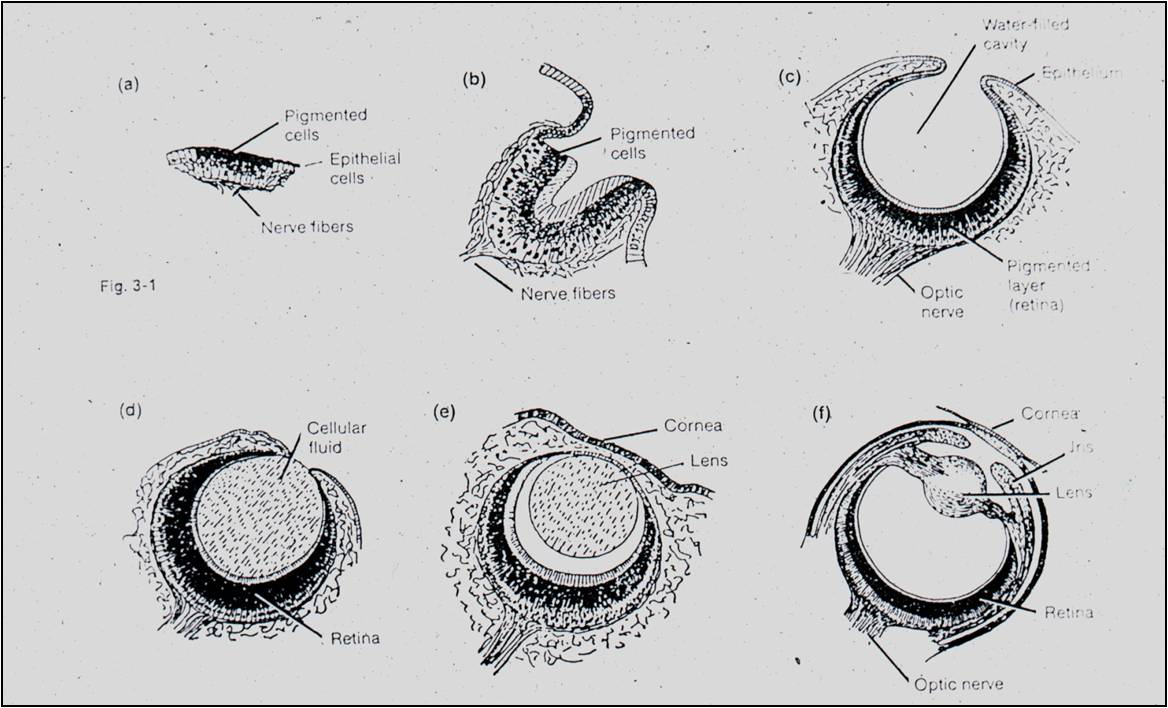 Well,
Darwin then describes the photoreceptive organs in molluscs. They range from
a sheet of receptive cells (a naked retina) to a cupped retina, to a lensless
pinhole eye, to an eye with a lens, to a camera eye. If this sequence exists
today, it is possible that this sequence could have existed through time, as
a sequential evolutionary series in eye evolution. Half an eye CAN work, if
the half you evolve first is the retina. The following videos from David
Attenborough and Richard
Dawkins are particularly good at describing the likely evolutionary scenario.
Well,
Darwin then describes the photoreceptive organs in molluscs. They range from
a sheet of receptive cells (a naked retina) to a cupped retina, to a lensless
pinhole eye, to an eye with a lens, to a camera eye. If this sequence exists
today, it is possible that this sequence could have existed through time, as
a sequential evolutionary series in eye evolution. Half an eye CAN work, if
the half you evolve first is the retina. The following videos from David
Attenborough and Richard
Dawkins are particularly good at describing the likely evolutionary scenario.
2. Where are all the intermediates?
“…why, if species have descended from other species by insensibly fine gradations, do we not everywhere see innumerable transitional forms? Why is not all nature in confusion instead of the species being, as we see them, well defined? … as by this theory innumerable transitional forms must have existed, why do we not find them embedded in countless numbers in the crust of the earth?” The Origin of Species (Darwin 1859).
Darwin was well aware that his uniformitarian hypothesis would require populations to change continuously and gradually through time. And although Lamarck's work on molluscs showed this type of change, most other lineages were best described as discontinuous and incomplete. And of course, and most importantly, the hypothesis of common ancestry predicts the existence of transitional species, representing the first evolutionary steps in the evolution of a major new group. No transitional fossils had been discovered by 1859.
There was another set of 'intermediates' that Darwin's hypothesis predicted - internediates between existing species. In other words, what would prevent the intermediates in a temporal sequence to leave descendants of their intermediate forms, thus making a continuous sequence of LIVING species between sister taxa? This continuity would make resolving one species from another almost impossible ("nature in confusion"). Darwin addressed this issue first. He said that selection, itself, would solve this issue. A more efficient descendant, with new adaptive traits, would competitively eliminate less adapted, ancestral forms:
“As natural selection acts solely by the preservation of profitable modifications, each new form will tend in a fully-stocked country to take the place of, and finally to exterminate, its own less improved parent or other less-favoured forms with which it comes into competition. Thus extinction and natural selection will, as we have seen, go hand in hand. Hence, if we look at each species as descended from some other unknown form, both the parent and all the transitional varieties will generally have been exterminated by the very process of formation and perfection of the new form.” – The Origin of Species (Darwin 1859)
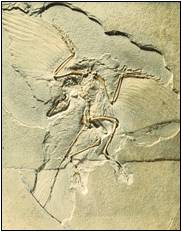 With
respect to intermediate and transitional fossils, Darwin suggested that the
fossil record was incomplete. Fossilization was a very rare event, and thus
it would be very unlikely for a representative of each species in a lineage
to have a representative preserved. However, he hope that, in time, a more complete
picture (and some truly transitional fossils) would be discovered. In 1861,
he was pleased by the discovery of Archeopteryx lithographica in Bavaria.
When previous fossils of this species had been unearthed, they were classified
as reptiles because they had teeth, fingers, and a long bony tail. But, when
this fossil (and 9 others since) were pulled from the very fine sedimentary
deposits of Bavaria, the impression of feathers were seen. So, here is an organism
with a very odd combination of traits - a lizard skeleton covered by feathers.
With
respect to intermediate and transitional fossils, Darwin suggested that the
fossil record was incomplete. Fossilization was a very rare event, and thus
it would be very unlikely for a representative of each species in a lineage
to have a representative preserved. However, he hope that, in time, a more complete
picture (and some truly transitional fossils) would be discovered. In 1861,
he was pleased by the discovery of Archeopteryx lithographica in Bavaria.
When previous fossils of this species had been unearthed, they were classified
as reptiles because they had teeth, fingers, and a long bony tail. But, when
this fossil (and 9 others since) were pulled from the very fine sedimentary
deposits of Bavaria, the impression of feathers were seen. So, here is an organism
with a very odd combination of traits - a lizard skeleton covered by feathers.
- IMPORTANT: Now, the existence of this odd animal is not the only thing that bears on evolution. Obviously, evolution does predict the existence of intermediates. But even more so, it also predicts WHEN in the fossil record this species should have lived. For instance, If Archeopteryx is a transitional species, it has to be after reptiles appear in the fossil record, and before true birds. It can't just be anywhere and be a transitional species between these groups. Well, it is just where evolutionary theory predicts it should be; after other reptiles and before all true birds. We will see lots of intermediates later in the course, when we look at post-Darwinian developments.
3. How is heritable variation produced?
Darwin's genius was seeing the importance of heritable variation; it would lead to differential reproductive success and evolutionary change. However, he did not understand how this variation was produced (mutation and recombination) or inherited (meiosis and heredity). He knew how important this was for his theory, and he was a real scientific student of hybridization experiments. One of the most difficult chapters in The Origin of Species is his extensive summary of patterns of hybridization across the animal and plant kingdoms. It is obvious that he hoped to find patterns in comparing these disparate studies that would reveal a mechanism of heredity. Unfortunately, they did not. As such, Darwin relied on those old Lamarckian ideas of "inheritance of acquired traits" (described as the effects of the 'external conditions of life') and "use and disuse":
"These laws, taken
in the largest sense, being Growth with Reproduction; Inheritance which is almost
implied by reproduction; Variability from the indirect
and direct action of the external conditions of life, and from use and disuse;
a Ratio of Increase so high as to lead to a Struggle for Life, and as a consequence
to Natural Selection…". - The Origin of Species
(Darwin 1859).
Darwin proposed the existence
of particulate 'gemmules' that were present in every cell of the body. Changes
in the body changed these gemmules somehow, and before mating these gemmules
migrated to the reproductive tissue for transmission to the next generation
- explaining how acquired traits could be inherited. He even did experiment
to test his idea, which he falsified. Yet, he had no other ideas. He
died not appreciating the insights that had been made by Mendel in Austria in
1865.
E. A Summary of Darwinian Evolution:
Darwin's view of evolution can be summarized as follows:
Source of variation: UNKNOWN
but variation is observable
Causes of Evolutionary Change:
(factors that cause change in natural populations): Natural Selection
Study Questions:
1. What is "uniformitarianism" and how was it important to the development of Darwin's ideas?
3. What observations did Hutton make, and what did he conclude from these observations?
4. What two patterns occur in the fossil record that impress Darwin regarding the hypothesis of evolution and common descent?
5. What are homologous structures? What correlations occurs with the environment?
6. What are analogous structures? What correlation occurs with the environment?
7. What are vestigial structures, and why were they so important to Darwin's refutation of Paley?
8. How did Darwin explain the existence of 'convergent communities"?
9. The Galapagos are dominated by many unique species of reptiles, birds, and marine mammals. What did this non-random assemblage suggest to Darwin about their origin, and how was evolution implied?
10. Why were the mockingbirds so critical to Darwin's ideas about the production of new species?
11. How did Darwin use the comparative method and observations of 'artificial selection' to produce the theory of 'natural selection'?
12. How were Malthus's observations and conclusion rlevant to the development of Darwin's theory?
13. Outline the theory of natural selection as an argument, with three premises, 3 conclusions, and a corollary.
14. How did Darwin solve Paley's dilemma regarding the stepwise evolution of a 'camera' eye?
15. How did Darwin explain the absence of LIVING intermediate forms?
16. How did Darwin explain the absence of EXTINCT intermediate forms?
17. How did Darwin believe that variation was produced in natural populations?
18. Outline Darwin's model of evolution, listing 'sources of variation' and 'causes of evolutionary change'.